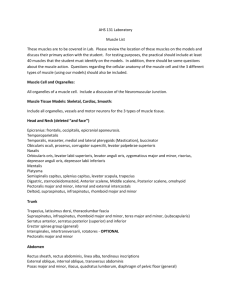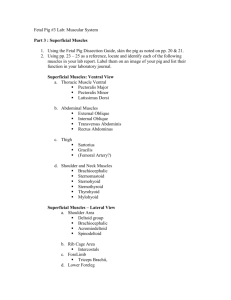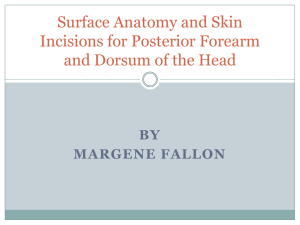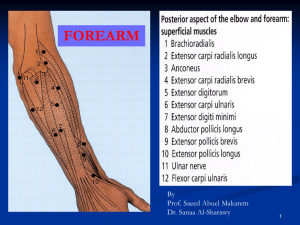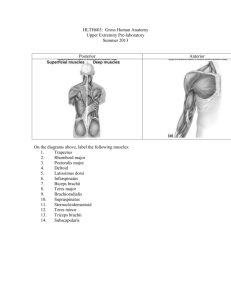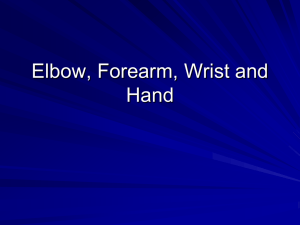13 ms Forearm2011-12
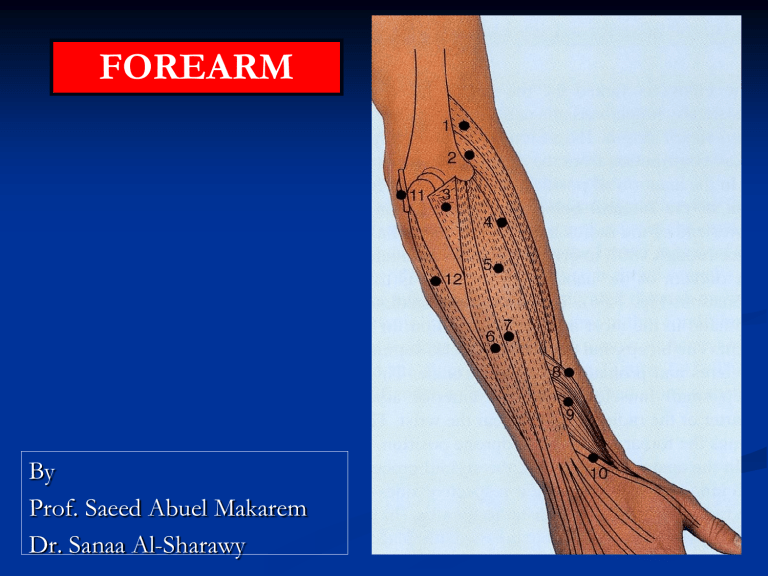
FOREARM
By
Prof. Saeed Abuel Makarem
Dr. Sanaa Al-Sharawy
The forearm extends from elbow to wrist.
It posses two bones radius laterally & Ulna medially.
The two bones are connected together by the interosseous membrane.
This membrane allows movement of
Pronation and
Supination while the two bones are connected together.
Also it gives origin for the deep muscles.
The forearm is enclosed in a sheath of deep fascia, which is attached to the posterior border of the ulna .
This fascial sheath, together with the interosseous membrane & fibrous intermuscular septa, divides the forearm into several compartments, each having its own muscles, nerves, and blood supply.
Fascial Compartments of the Forearm
These muscles : are ( 8)
• They act on the elbow & wrist joints and the fingers.
• They form fleshy masses in the proximal part and become tendinous in the distal part of the forearm.
• They are arranged in three groups:
I-Superficial: 4
Pronator teres
Flexor carpi radialis
Palmaris longus
Flexor carpi ulnaris
Anterior compartment
II-Intermediate: 1
Flexor digitorum superficialis
III- Deep: 3
FLEXOR GROUP
Flexor digitorum profundus
Flexor pollicis longus
Pronator quadratus
Superficial Flexors
They arise - more or less- from the common flexor origin (front of
medial epicondyle).
All are supplied by median nerve except one, flexor carpi ulnaris, FCU (ulnar n.).
All cross the wrist joint except one , pronator teres, (PT).
Pronator teres
Insertion: middle of lat. surface of radius
Action : pronation & flexion of forearm .
Flexor Carpi
Radialis
Insertion : Base of 2 nd metacarpal bone
Action : Flexion & abduction of the wrist.
Palmaris Longus
Insertion : into the flexor retinaculum & palmer aponeurosis.
Action : Flexes hand & tightens the palmer aponeurosis
May
Be
Absent
Flexor Carpi
Ulnaris
Insertion :
Pisiform, hook of hamate
5 th metacarpal bone
Action :
Flexion and adduction of the hand (wrist)
Flexor Digitorum
Superficialis
•
Origin:
•
• Common flexor origin,
Coronoid process of ulna;
•
•
•
•
• Anterior surface of radius
Insertion : base of middle phalanges of the medial 4 fingers.
Action :
Flexes middle and proximal phalanges of medial 4 fingers, and the hand
(wrist).
Deep Flexors
One above radius :
Flexor pollicis longus
One above ulna :
Flexor Digitorum profundus
One above the 2 bones:
Pronator Quadratus.
Flexor Digitorum
Profundus
Insertion : bases of the distal phalanges of the medial four digits
Action : Flexes distal phalanges of medial four digits
Flexor Pollicis Longus
Insertion : Base of distal phalanx of thumb
Action : flexes interphalangeal, metacarpophalangeal & carpometacarpal joints of thumb
Pronator Quadratus
• Insertion : distal fourth of ant. surface of radius
• Action : pronates forearm
(primover), helps to hold the bones together
Supination and pronation
It occurs in the superior and inferior radioulnar joints;
(pivot synovial joint)
Muscles produce supination
Biceps brachii.
Supinator.
Muscles produce pronation
Pronator teres.
pronator quadratus.
NB. Brachioradialis put the forearm in midprone-supine position.
Posterior compartment: 3 groups
Superficial group 5
Extensor carpi radialis brevis
Extensor digitorum
Extensor digiti minimi
Extensor carpi ulnaris
Anconeus (posterior of lateral epicondyle).
Origin:
Common Extensor Origin .
(front of lateral epicondyle).
Deep group 5 (3 to thumb+
Lateral group 2
Brachioradialis
Extensor carpi radialis longus
(The 2 muscles originate from the lateral supracondylar ridge) .
1 to index + supinator).
Supinator.
Abductor pollicis longus.
Extensor pollicis brevis.
Extensor pollicis longus.
Extensor indices.
Posterior compartment
I- Superficial group:
7 muscles ( from lateral to medial)
Brachioradialis, (BR).
Extensor carpi radialis longus, (ECRL).
Extensor carpi radialis brevis, (ECRB).
Extensor digitorum,
(ED).
Extensor digiti minimi,
(EDM).
Extensor carpi ulnaris,
(ECU).
Anconeus. (An).
Superficial extensor
All arises from the common extensor origin , (front of lateral epicondyle) of the humerus,
EXCEPT , 2 (BR & EXRL).
All cross the wrist EXCEPT, one, (brachioradialis.
All supplied by deep branch of radial nerve, EXCEPT ABE
A , anconeus
B , Brachioradialis
E , Extensor carpi radialis longus
These 3 muscles are supplied by the radial nerve itself
Brachioradialis
Origin:
Lateral supracondylar ridge of humerus
Insertion:
Base of styloid process of radius
Action :
Flexes forearm;
(elbow).
Rotates forearm to the midprone position
Extensor
Carpi radialis longus
Origin:
Lateral supracondylar ridge of humerus
Insertion:
Posterior surface of base of second metacarpal bone
Action :
Extends and abducts hand at wrist joint
INSERTION
Extensor carpi radialis brevis: base of 3 rd metacarpal bone.
Extensor digitorum:
Extensor expansion of the medial
4 fingers.
Extensor digiti minimi :
Extensor expansion of the little finger.
Extensor carpi ulnaris:
Base of the 5 th metacarpal bone.
II- Deep group:
5 muscles
1- Abductor pollicis longus, (APL).
2- Extensor pollicis brevis, (EPB).
3- Extensor pollicis longus, (EPL).
4- Extensor indicis
(EI).
5- Supinator.
All back muscles of forearm are supplied by posterior interosseous nerve except , ABE by
Radial nerve.
Dorsal Extensor Expansion
It is formed by the union of the tendons of: Extensor digitorum,
Extensor indicis, extensor digiti minimi, palmar & dorsal interossei and lumbricals muscles.
All these tendons unite to form one tendon which divides into 3 slips, a median one attached to middle phalanges and 2 lateral attached to the terminal phalanges.
